Lexus HS250h 2010 Hybrid System / LEXUS 2010 HS250H OWNERS MANUAL (OM75006U)
Manufacturer: LEXUS, Model Year: 2010, Model line: HS250h, Model: Lexus HS250h 2010Pages: 608, PDF Size: 9.89 MB
Page 101 of 608
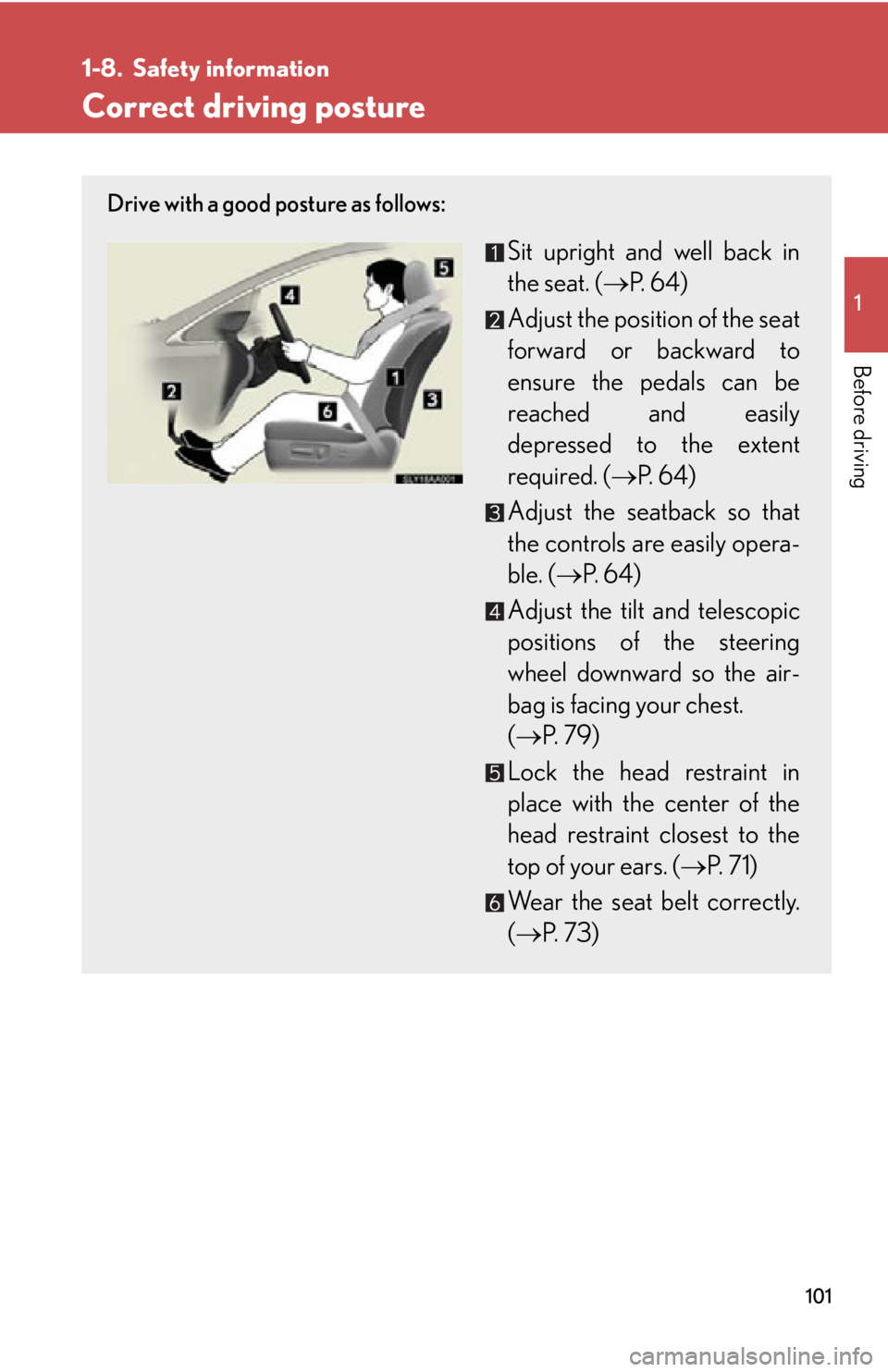
101
1
Before driving
1-8. Safety information
Correct driving posture
Drive with a good posture as follows:
Sit upright and well back in
the seat. ( P. 6 4 )
Adjust the position of the seat
forward or backward to
ensur
e the pedals can be
reached and easily
depressed to the extent
required. ( P. 6 4 )
Adjust the seatback so that
the controls are easily opera -
ble. ( P. 6 4)
Adjust the tilt and telescopic
positions of the steering
wheel do
wnward so the air -
bag is facing your chest.
( P. 7 9 )
Lock the head restraint in
place with the center of the
head r
estraint closest to the
top of your ears. ( P. 7 1 )
Wear the seat belt correctly.
( P. 7 3 )
Page 102 of 608

102
1-8. Safety information
CAUTION
■While driving
●Do not adjust the position of the driver’s seat.
Doing so could cause the driver to lose control of the vehicle.
●Do not place a cushion between the driver or passenger and the seatback.
A cushion may prevent correct posture from being achieved, and reduce the
effectiveness of the seat belt and head re straint, increasing the risk of death or
serious injury to the driver or passenger.
●Do not place anything under the front seats.
Objects placed under the front seats may become jammed in the seat tracks and
stop the seat from locking in place. This may lead to an accident, resulting in
death or serious injury. The adjustment mechanism may also be damaged.
■Adjusting the seat position
●Take care when adjusting the seat position to ensure that other passengers are
not injured by the moving seat.
●Do not put your hands under the seat or near the moving parts to avoid injury.
Fingers or hands may become jammed in the seat mechanism.
Page 103 of 608

103
1
1-8. Safety information
Before driving
SRS airbags
The SRS airbags inflate when the vehicle is subjected to certain types of
severe impacts that may cause signific ant injury to the occupants. They
work together with the seat belts to he lp reduce the risk of death or serious
injury.
SRS front airbags
SRS driver airbag/front passenger airbag
Can help protect the head and ch est of the driv
er and front passen-
ger from impact with interior components
SRS knee airbags
Can help provide driver and front passenger protection
Page 104 of 608
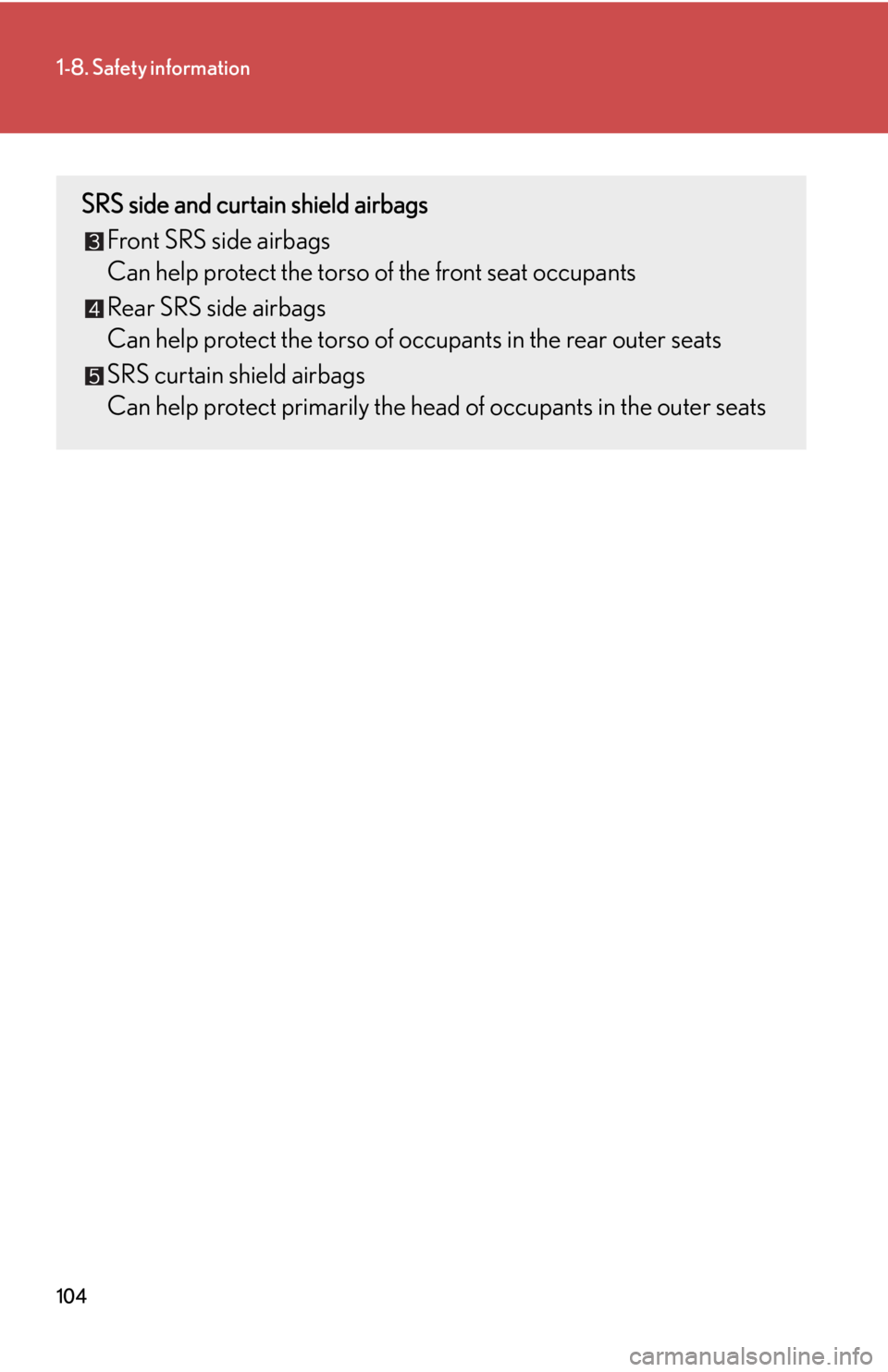
104
1-8. Safety information
SRS side and curtain shield airbags
Front SRS side airbags
Can help protect the torso of the fr
ont seat occupants
Rear SRS side airbags
Can help protect the torso of o ccupants in the r
ear outer seats
SRS curtain shield airbags
Can help protect primarily the he ad of occupants in the outer seats
Page 105 of 608
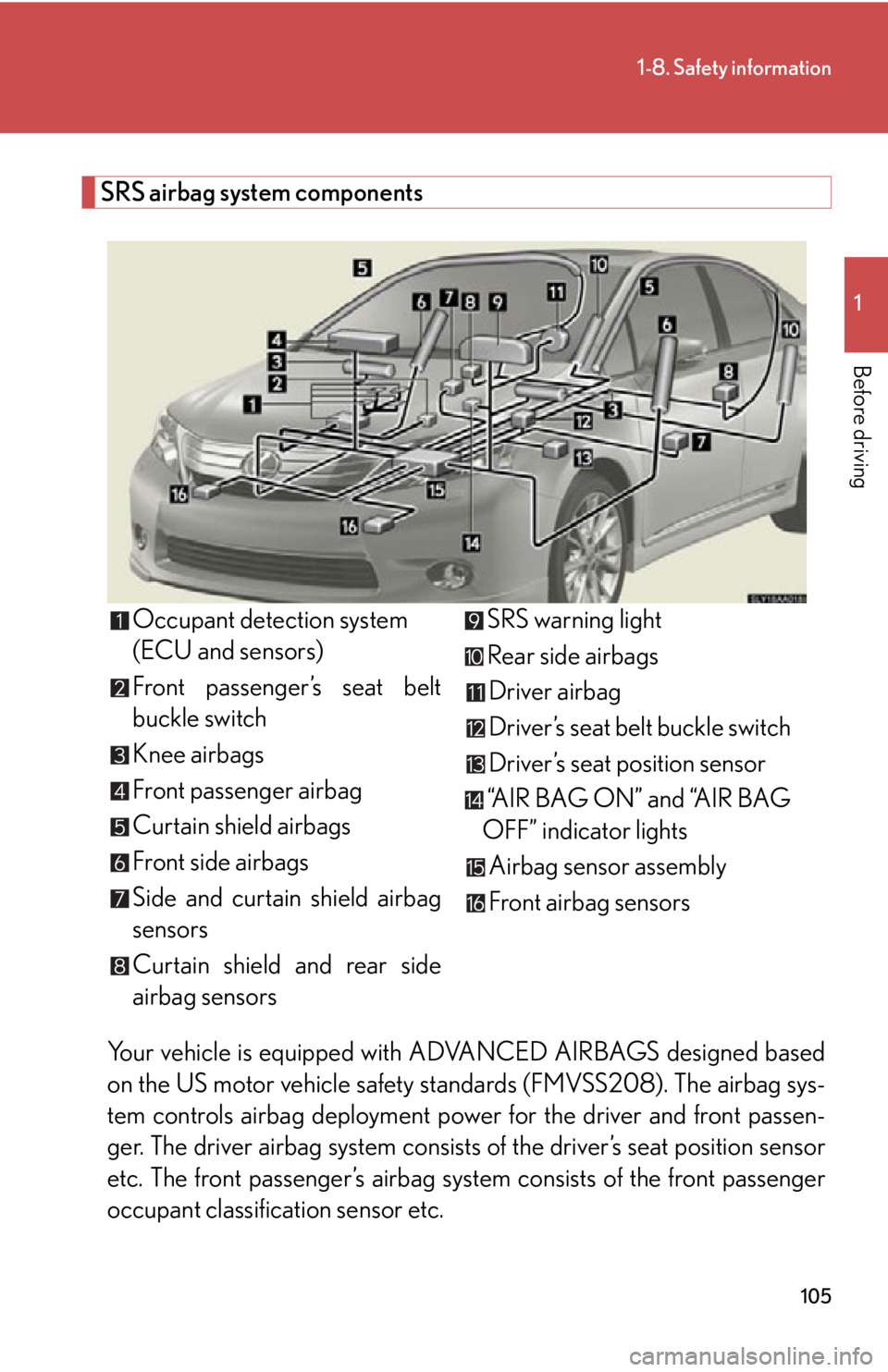
105
1-8. Safety information
1
Before driving
SRS airbag system components
Your vehicle is equipped with ADVANCED AIRBAGS designed based
on the US motor vehicle safety standards (FMVSS208). The airbag sys -
tem controls airbag deployment pow er for the driv
er and front passen-
ger. The driver airbag system consists of the driv
er’s seat position sensor
etc. The front passenger’s airbag system consists of the front passenger
occupant classification sensor etc.
Occupant detection system
(ECU and sensors)
Front passenger’s seat belt
buckle switch
Knee airbags
Front passenger airbag
Curtain shield airbags
Front side airbags
Side and curtain shield airbag
sensors
Curtain shield and rear side
airbag sensors SRS warning light
Rear side airbags
Driver airbag
Driver’s seat belt buckle switch
Driver’s seat position sensor
“AIR BAG ON” and “AIR BAG OFF” indicator lights
Airbag sensor assembly
Front airbag sensors
Page 106 of 608

106
1-8. Safety information
The main SRS airbag system components are shown above. The SRS air-
bag system is controlled by the airb ag sensor as
sembly. The airbag sen-
sor assembly consists of a safing sensor and an airbag sensor.
In certain types of severe frontal or side impacts, the SRS airbag s
ystem
triggers the airbag inflators. A chemica l reaction in the inflators quickly
fills the airbags with non-toxic gas to help restrain the motion of the occu -
pants.
■If the SRS airbags deploy (inflate)
●Bruising and slight abrasion s may result from contact with a deploying (inflating)
SRS airbag.
●A loud noise and white powder will be emitted.
●Parts of the airbag module (steering wheel hub, airbag cover and inflator) as
well as the seats, parts of the front and rear pillars, and roof side rails, may be hot
for several minutes. The airbag itself may also be hot.
●The windshield may crack.
●For Safety Connect subscribers, if the SRS airbags deploy or in the event of a
severe rear-end collision, the system is designed to send an emergency call to
the response center, notifying them of the vehicle’s location (without needing to
push the “SOS” button) and an agent will attempt to speak with the occupants
to ascertain the level of emergency and assistance required. If the occupants
are unable to communicate, the agent automatically treats the call as an emer -
gency and helps to dispatch the necessary emergency services. ( P. 3 9 5 )
■Operating conditions (SRS front airbags)
●The SRS front airbags will deploy in the event of an impact that exceeds the set
threshold level (the level of force corresponding to a 12-18 mph [20-30 km/h]
frontal collision with a fixed wall that does not move or deform).
However, this threshold velocity will be considerably higher if the vehicle strikes
an obje
ct, such as a parked vehicle and sign pole, which can move or deform on
impact, or if the vehicle is involved in an underride collision (e.g. a collision in
which the front of the vehicle “underrides”, or goes under, the bed of a truck, etc.).
●It is possible that in some collisions where the forward deceleration of the vehi -
cle is very close to the designed thresh ol
d level, the SRS front airbags and the
seat belt pretensioners ma y not activate together.
Page 107 of 608

107
1-8. Safety information
1
Before driving
●The SRS front passenger airbag will not activate if there is no passenger sitting
in the front passenger seat. However, the SRS front passenger airbag may
deploy if luggage is put in the seat, or the seat belt is fastened, even if the seat is
unoccupied. (P. 7 3 )
■Operating conditions (SRS side airbags and curtain shield airbags)
The SRS side airbags and SRS curtain shield airbags will deploy in the event of an
impact that exceeds the set threshold level (the level of force corresponding to the
impact force produced by a 3307 lb. [1500 kg] vehicle colliding with the vehicle
cabin from a direction perpendicular to the vehicle orientation at a speed of 12 -18
mph [20 -30 km/h]).
■Conditions under which the SRS airbags may deploy (inflate), other than a colli-
sion
The SRS front airbags may also deploy if a serious impact occurs to the underside of
your vehicle. Some examples are shown in the illustration.
■Types of collisions that may not deploy the SRS airbags (SRS front airbags)
The SRS front airbags are generally not designed to inflate if the vehicle is involved
in a side or rear collision, if it rolls over, or if it is involved in a low-speed frontal colli-
sion. But, whenever a collision of any type causes sufficient forward deceleration of
the vehicle, deployment of th e SRS front airbags may occur.
●Hitting a curb, edge of pavement or hard
surface
●Falling into or jumping over a deep hole
●Landing hard or falling
●Collision from the side
●Collision from the rear
●Vehicle rollover
Page 108 of 608
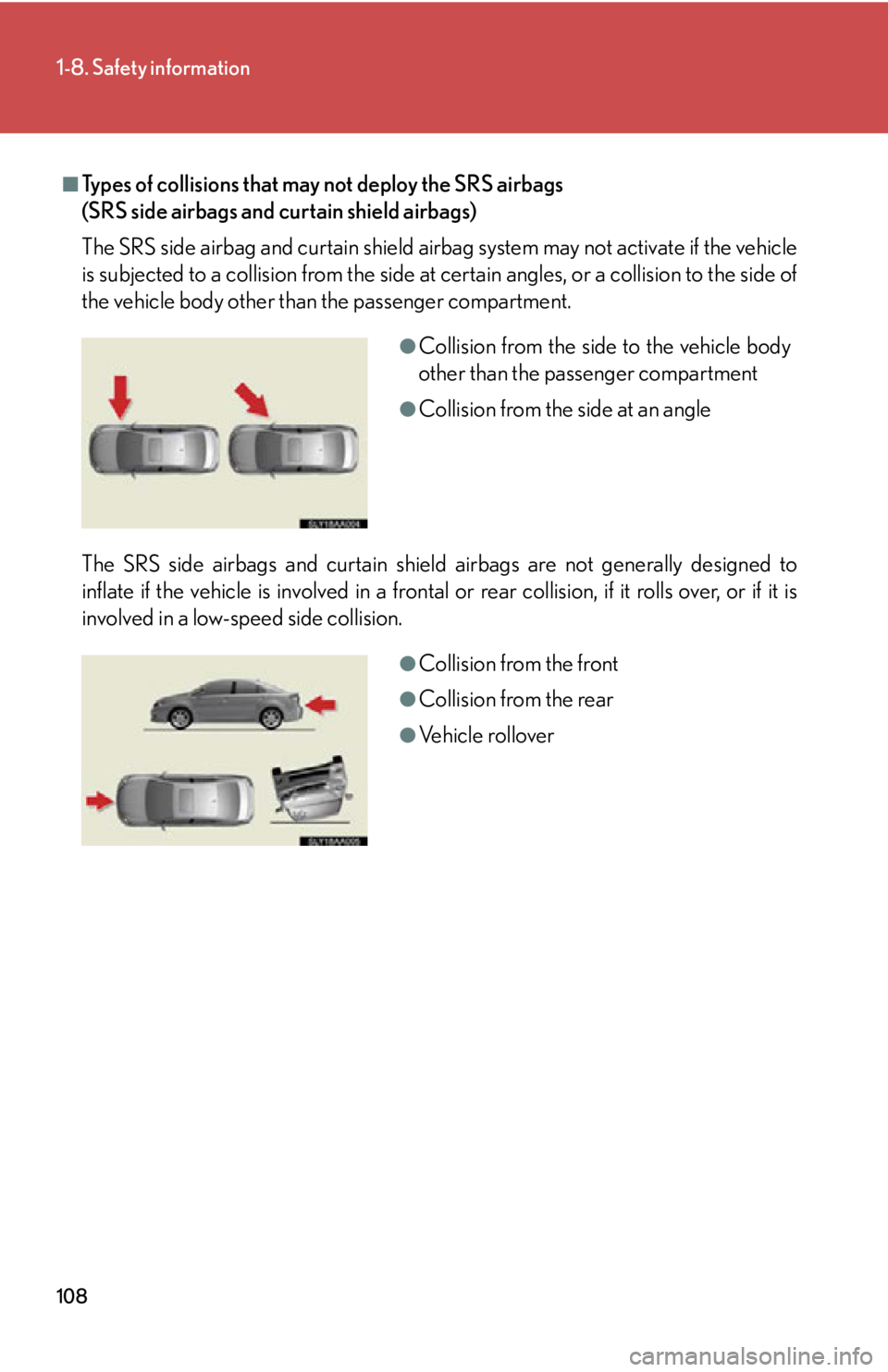
108
1-8. Safety information
■Types of collisions that may not deploy the SRS airbags
(SRS side airbags and curtain shield airbags)
The SRS side airbag and curtain shield ai rbag system may not activate if the vehicle
is subjected to a collision from the side at certain angles, or a collision to the side of
the vehicle body other than the passenger compartment.
The SRS side airbags and curtain shield airbags are not generally designed to
inflate if the vehicle is involved in a frontal or rear collision, if it rolls over, or if it is
involved in a low-speed side collision.
●Collision from the side to the vehicle body
other than the passenger compartment
●Collision from the side at an angle
●Collision from the front
●Collision from the rear
●Vehicle rollover
Page 109 of 608
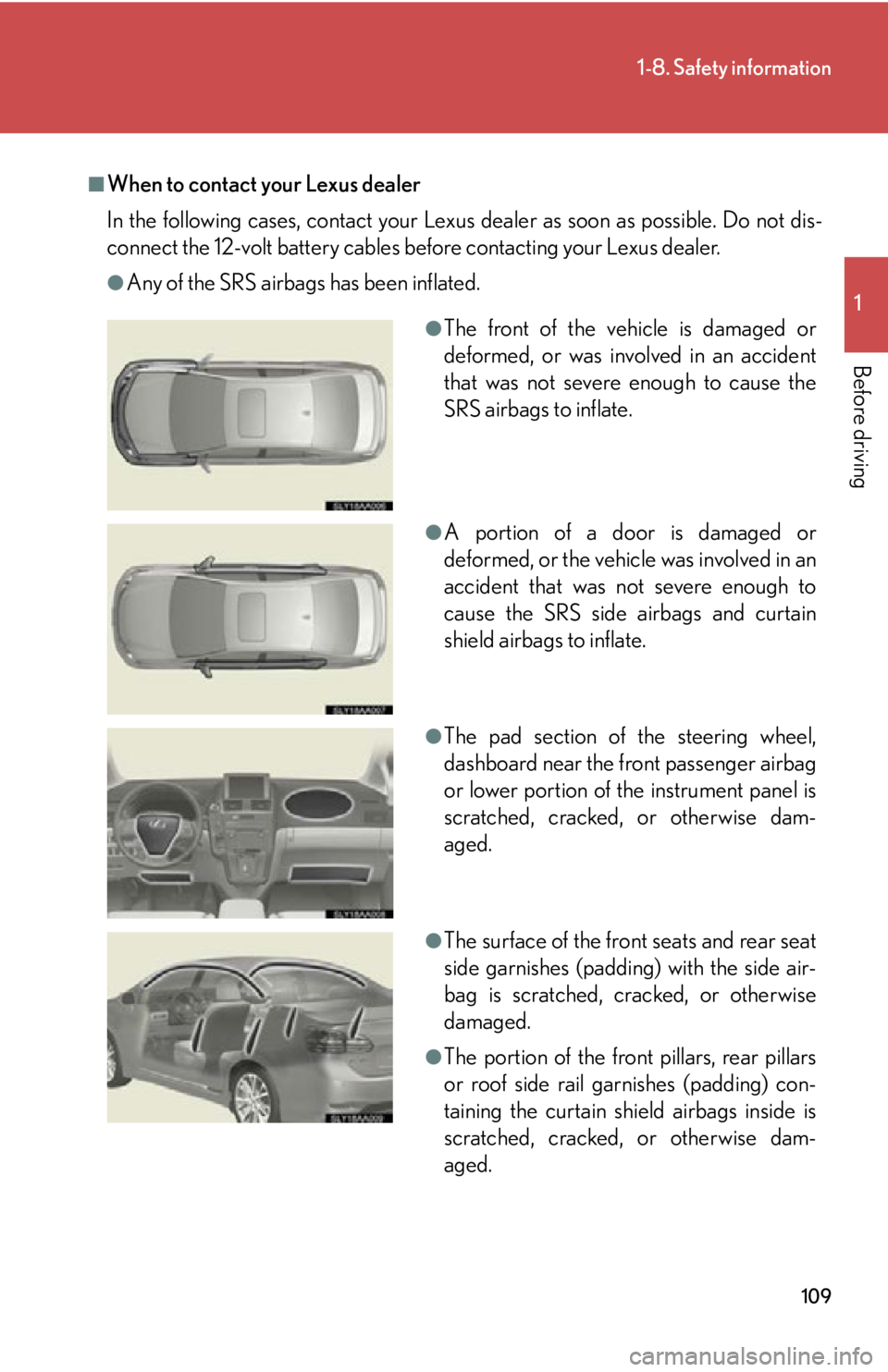
109
1-8. Safety information
1
Before driving
■When to contact your Lexus dealer
In the following cases, contact your Lexus dealer as soon as possible. Do not dis-
connect the 12-volt battery cables before contacting your Lexus dealer.
●Any of the SRS airbags has been inflated.
●The front of the vehicle is damaged or
deformed, or was involved in an accident
that was not severe enough to cause the
SRS airbags to inflate.
●A portion of a door is damaged or
deformed, or the vehicle was involved in an
accident that was not severe enough to
cause the SRS side airbags and curtain
shield airbags to inflate.
●The pad section of the steering wheel,
dashboard near the front passenger airbag
or lower portion of the instrument panel is
scratched, cracked, or otherwise dam-
aged.
●The surface of the front seats and rear seat
side garnishes (padding) with the side air-
bag is scratched, cracked, or otherwise
damaged.
●The portion of the front pillars, rear pillars
or roof side rail garnishes (padding) con-
taining the curtain shield airbags inside is
scratched, cracked, or otherwise dam-
aged.
Page 110 of 608

110
1-8. Safety information
CAUTION
■SRS airbag precautions
Observe the following precautions regarding the SRS airbags.
Failure to do so may cause death or serious injury.
●The driver and all passengers in the vehicle must wear their seat belts properly.
The SRS airbags are supplemental devices to be used with the seat belts.
●The SRS driver airbag deploys with considerable force, and can cause death or
serious injury especially if the driver is very close to the airbag. The National
Highway Traffic Safety Administration (NHTSA) advises:
Since the risk zone for the driver’s airbag is the first 2 - 3 in. (50 - 75 mm) of infla-
tion, placing yourself 10 in. (250 mm) from your driver airbag provides you with a
clear margin of safety. This distance is measured from the center of the steering
wheel to your breastbone. If you sit less than 10 in. (250 mm) away now, you can
change your driving position in several ways:
• Move your seat to the rear as far as you can while still reaching the pedals
comfortably.
• Slightly recline the back of the seat. Although vehicle designs vary, many dr ivers can achieve the 10 in. (250 mm)
distance, even with the driver seat all the way forward, simply by reclining the
back of the seat somewhat. If reclining the back of your seat makes it hard to
see the road, raise yourself by using a firm, non-slippery cushion, or raise the
seat if your vehicle has that feature.
• If your steering wheel is adjustable, ti lt it downward. This points the airbag
toward your chest instead of your head and neck.
The seat should be adjusted as recommended by NHTSA above, while still main-
taining control of the foot pedals, steering wheel, and your view of the instrument
panel controls.